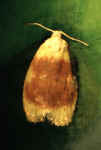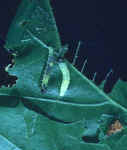 |
 |
|
Bell-shaped appearance of adult oak leaftier |
Oak leafroller damaged red oak leaves |
The oak leaftier, Croesia semipurpurana (Kearfott), and the oak leafroller, Archips semiferanus (Walker), are important Tortricidae moths in a complex of native species feeding in the early spring on oak foliage throughout the forests of Eastern North America. Outbreaks periodically develop with frequent and severe defoliation resulting in tree mortality. The last outbreak during the 1960's and 1970's covered large areas of Connecticut, Massachusetts, New York, Pennsylvania, Virginia, and West Virginia.
Either moth species may dominate during an outbreak depending upon which oak species are present. Oak leaftier caterpillars (larvae) tend to favor red, scarlet, black, and pin oaks; whereas, oak leafroller caterpillars feed not only on red and scarlet oaks, but also on chestnut and white oaks commonly found along ridgetops.
Resting adults of both species hold their wings in a characteristic bell shape. The adult wingspan of the oak leaftier is smaller (0.5 inch) than the oak leafroller (0.9 inch). Adults of both species are distinctly marked. The oak leaftier is yellow with a large, violet to brown front wing; the oak leafroller is creamy brown and gray with a darker oblique band across its front wing.
Despite their small size, larvae of both species, if abundant, can severely defoliate an oak tree. Newly hatched oak leaftier larvae enter opening buds and eat immature leaves. This feeding habit can destroy most new growth. Surviving leaves are deformed and riddled with holes. Oak leafroller larvae feed from leaves webbed together or rolled at the edges into shelters.
Larvae of both species exhibit various colors and markings as they mature. Immature larvae are several shades of green with a dark head capsule and thoracic shield and cannot easily be identified to species until they are mature. Mature oak leaftier larvae (left-facing) are 0.5 inch long with both a dark eye patch and a bar on the side of the head, and dark legs. Mature oak leafroller larvae (right-facing) are 1.2 inch long with either a dark eye patch or a dark bar on the head, and pale legs.
Information provided by the USDA Forest Service

